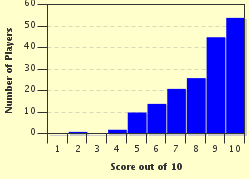Quiz Answer Key and Fun Facts
1. What do the chemical element with the symbol Sn and the atomic number of 50, a 1960s anti-war song covered for the movie "Billy Jack," and the lower part of a squash court's front wall which is out of bounds, have in common?
2. What do youth movements in communist countries, a series of unmanned U.S. space vehicles/missions to explore the solar system, and a memorial sculpture to honour the women who settled the Western frontier, have in common?
3. What do an element called cuivre in French, rame in Italian, Kupfer in German and shaba in Swahili, Agkistrodon contortrix mokasen, a snake native to the Eastern US, and salmon taken from the south-central Alaskan river which drains the Wrangell and Chugach Mountains have in common?
4. What do a Rossini opera about true love assisted by a Spanish tonsorialist, a Canadian cookbook author who was "The Urban Peasant" on television, and a professional golfer who played better as a senior than in his earlier career, have in common?
5. What do several varieties of wild "cabbage" named for their horrid odor, a Warner Brothers' character named Pepé Le Pew, and the nickname for Lockheed Martin's Advanced Development Programs have in common?
6. What do the airborne product of pyrolysis, the Platters (1958) asking "how I knew my true love was true," and a 1998 independent film based on a short story by Native American author Sherman Alexie have in common?
7. What do a Michael Crichton novel about an African expedition for diamonds versus the creatures who protect them, the school mascot of the Pittsburg State University in Pittsburg, Kansas, and the principal character in "The Great Grape Ape Show" have in common ?
8. What do the ABC network's weekday morning show known to many by its initials, a Christian hymn recorded by Cat Stevens before he became Yusuf Islam, and a Christian liturgy conducted at sunrise on Easter have in common?
9. What do early 20th Century jazz pianist, composer and band-leader Morton, bread formed for individual servings rather than as a large loaf, and film or video footage of secondary material, cut-away shots, establishing shots, have in common?
10. What do an all-American comic-book hero created in 1940 to combat Nazis, a 1936 Shirley Temple film about an orphan girl raised in a lighthouse, and a Walt Whitman poem about the death of Abraham Lincoln have in common?
Source: Author
FatherSteve
This quiz was reviewed by FunTrivia editor
agony before going online.
Any errors found in FunTrivia content are routinely corrected through our feedback system.


